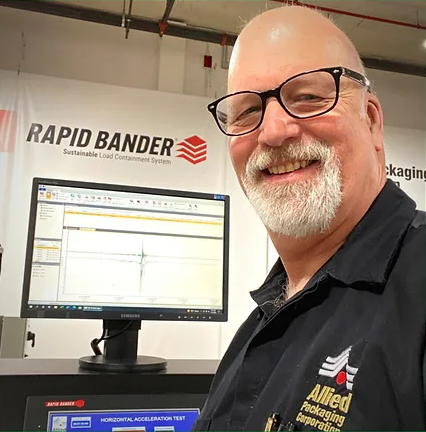Ask Steve
December 21, 2023
Question from Miles: We are getting a lot of pressure from corporate to use stretch film with post-consumer recycled content. If we do, will we be able to achieve the same load containment that we have now?
Hi Miles, Your question could not have been better timed. There is a lot of discussion regarding corporate directives as well as upcoming state and federal regulations that are pushing in the direction of PCR films, and I see a growing number of products that are marketed specifically to answer that demand. So, I am going to step away from the marketing hype you may be hearing and give you some solid (science-based) facts that I hope will help you make the right decisions.
First, we absolutely believe that the use of post-consumer recycled content for materials like stretch film is the future, unfortunately though, we live in the present. We are constantly experimenting with different resin blends and process variations to achieve higher PCR performance, but the science just isn’t there yet. Demands and regulation cannot make something, however good it might be, cost effective and perform to the standard needed today, it’s just a fact.
To really grasp the complex subject of PCR stretch film, let’s break it down into performance, cost, availability, and finally, alternatives.
Starting with performance; we have an Advanced Load Containment Test Lab here in Phoenix where we have tested about every stretch film available (PCR films included). With that extensive database, we can quantify the performance of films under real-life conditions. Film manufacturers differ from us by testing film for ultimate strength, meaning how far you can stretch it and how much force you can generate by stretching it over a distance. Many will use that data to show that their PCR film will perform just as well as a film with no PCR content. While their lab data may look great, if you can’t achieve that in the field because the web breaks at sharp corners when you try to wrap a load, then ultimate strength, as a metric of performance, doesn’t mean much.
PCR films are made using recycled plastic material, shredding it, clarifying it, pelletizing it, mixing it with some percentage of virgin resin, and finally extruding it. The film is extruded with at least three layers with the PCR as the center or core layer between a “skin” layer on either side of virgin resin. The amount of PCR in the core can vary but it will not be 100%. The challenge is that once it has undergone a heat cycle, when it was originally processed, the PCR resin will not melt, or plasticize, at the same temperature as virgin resin. This temperature differential causes gels to form where the PCR does not fully incorporate into the virgin resin that is part of the core layer. The gels do not stretch at the same rate as the surrounding virgin resin and thus become a failure point when stretched far enough to achieve good containment force, or the film is punctured. Gels become more critical the thinner the film, so the best performing PCR films in the market tend to be thicker.
Time to tackle cost. In science and in business, we look at critical mass, or the point at which the amount (of something) is large enough to produce a particular result or change. Collecting, separating, processing, and distributing PCR is a cost that non-PCR films do not have. The energy required to process PCR is higher than non-PCR films. The loss of yield to the film manufacturer with PCR films is a cost. So, logic dictates that PCR film must cost more than non-PCR film in today’s world. The difference between the two will vary but it is common sense that manufacturers cannot sell PCR films for the same price per pound (if they want to remain a viable business). Circling back to critical mass, as the volume of PCR films increases, some of those costs will naturally come down, closing the price gap between PCR and non-PCR films. However, even if they cost the same per pound today, to achieve the same load containment, you would have to apply more film, and generally a thicker film, than you would with non-PCR film. That is because when you use PCR film, you will need to reduce wrap tension and/or pre-stretch to prevent web breaks while wrapping, in addition to applying extra wraps to achieve a load containment standard.
On to availability. Most plastic material that we toss into the recycle bin, unfortunately, ends up in the landfill. The infrastructure just isn’t in place today to process recycled material. The locations that are equipped to separate plastics into various categories are limited, therefore, even though ample supply of recyclable material may be available based on today’s need, if we all adopted the use of PCR, the supply chain is simply not in place to support the resulting demand. If PCR feedstock is unavailable, the backup is to use virgin resin in place of PCR, but that absolutely defeats the purpose.
Finally (at last you say) let’s discuss alternatives. Until the challenges I outlined above are solved, our solution has been to focus on source reduction. The Rapid Technologies approach (Rapid Bander, Rapid Roper, Rapid Roper Plus) are all designed to provide exceptional load containment. Most of our customers have been able to reduce the amount of stretch film they use by 50%-60%. That translates to less material produced; less material transported, less material disposed of or hauled away, and less material in the landfills. All of these have a direct and positive impact on sustainability by eliminating energy use and greenhouse gas emission - better for the planet, and you have the same load containment, or better, without having to pay more per wrapped load. If you happen to use corner boards and strapping, there is a very good chance they can be eliminated altogether using our patented technology, which would be an extraordinary opportunity for cost reduction while going a long way to achieve your corporate sustainability goals.
We can provide you with a viable, cost-effective sustainable solution today. Anyone who has followed my Ask Steve articles knows that I am all about science. With that focus in mind, development continues so we stay on the industry’s leading edge, providing maximum load containment, cost-effective performance, and sustainable solutions.
Thanks for asking!








